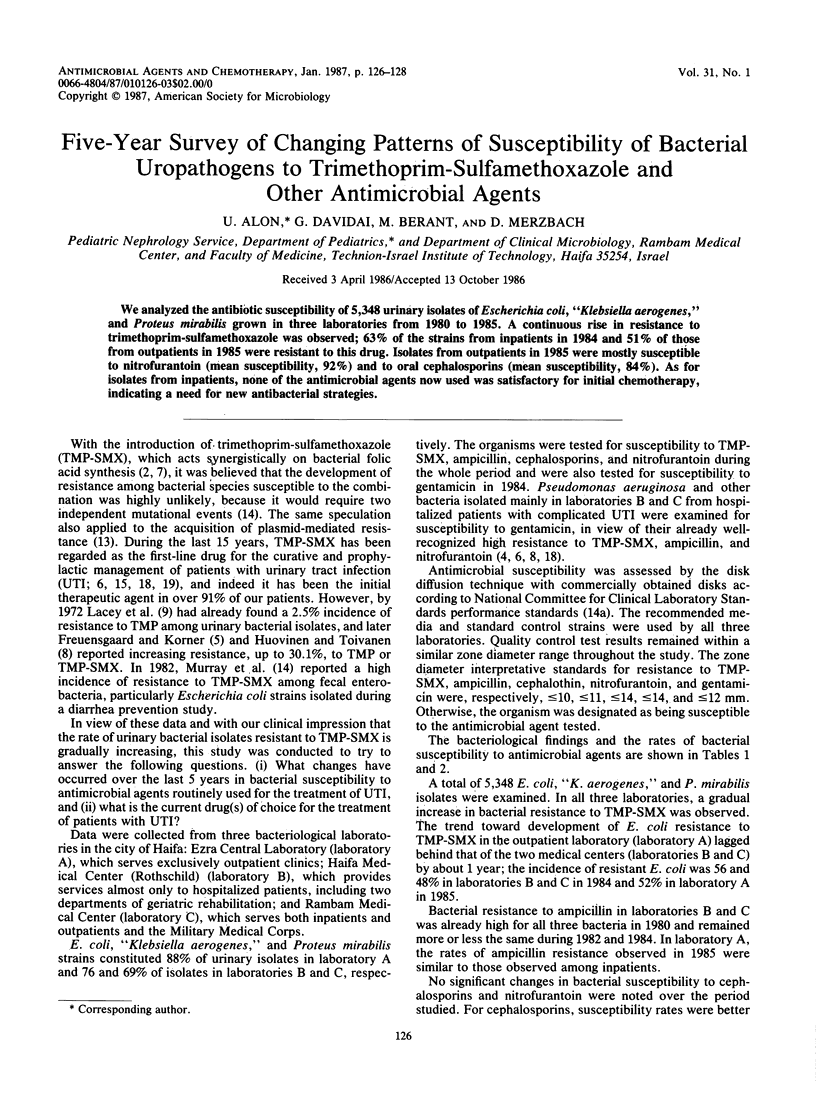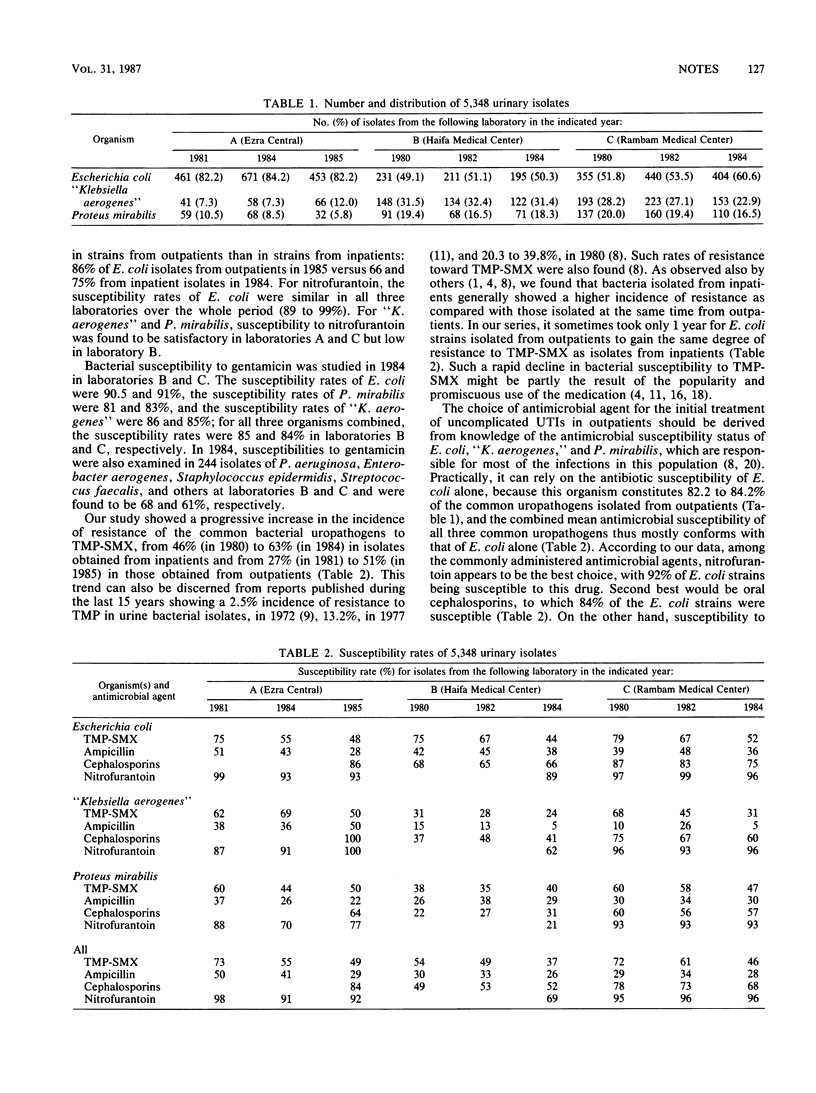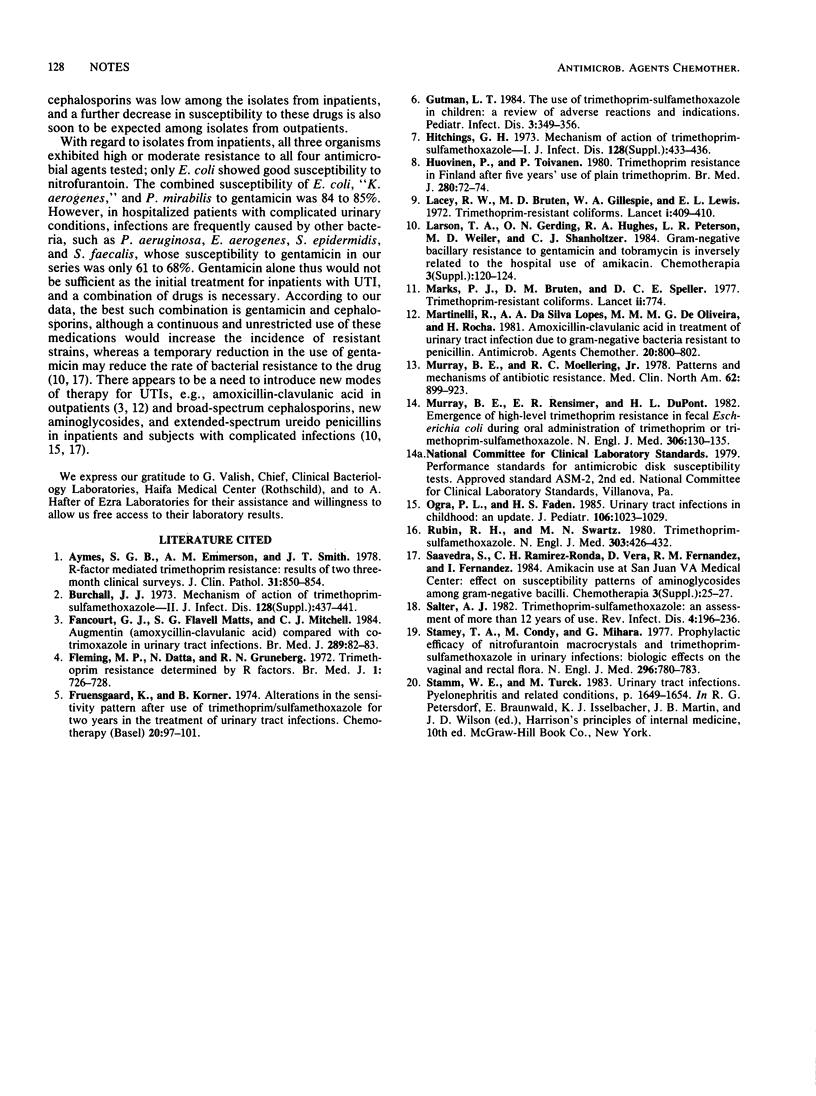Abstract
We analyzed the antibiotic susceptibility of 5,348 urinary isolates of Escherichia coli, "Klebsiella aerogenes," and Proteus mirabilis grown in three laboratories from 1980 to 1985. A continuous rise in resistance to trimethoprim-sulfamethoxazole was observed; 63% of the strains from inpatients in 1984 and 51% of those from outpatients in 1985 were resistant to this drug. Isolates from outpatients in 1985 were mostly susceptible to nitrofurantoin (mean susceptibility, 92%) and to oral cephalosporins (mean susceptibility, 84%). As for isolates from inpatients, none of the antimicrobial agents now used was satisfactory for initial chemotherapy, indicating a need for new antibacterial strategies.
Full text
PDF


Selected References
These references are in PubMed. This may not be the complete list of references from this article.
- Amyes S. G., Emmerson A. M., Smith J. T. R-factor mediated trimethoprim resistance: result of two three-month clinical surveys. J Clin Pathol. 1978 Sep;31(9):850–854. doi: 10.1136/jcp.31.9.850. [DOI] [PMC free article] [PubMed] [Google Scholar]
- Burchall J. J. Mechanism of action of trimethoprim-sulfamethoxazole. II. J Infect Dis. 1973 Nov;128(Suppl):–441. doi: 10.1093/infdis/128.supplement_3.s437. [DOI] [PubMed] [Google Scholar]
- Fancourt G. J., Matts S. G., Mitchell C. J. Augmentin (amoxycillin-clavulanic acid) compared with co-trimoxazole in urinary tract infections. Br Med J (Clin Res Ed) 1984 Jul 14;289(6437):82–83. doi: 10.1136/bmj.289.6437.82. [DOI] [PMC free article] [PubMed] [Google Scholar]
- Fleming M. P., Datta N., Grüneberg R. N. Trimethoprim resistance determined by R factors. Br Med J. 1972 Mar 18;1(5802):726–728. doi: 10.1136/bmj.1.5802.726. [DOI] [PMC free article] [PubMed] [Google Scholar]
- Fruensgaard K., Korner B. Alterations in the sensitivity pattern after use of trimethoprim-sulfamethoxazole for two years in the treatment of urinary tract infections. Chemotherapy. 1974;20(2):97–101. doi: 10.1159/000221797. [DOI] [PubMed] [Google Scholar]
- Gutman L. T. The use of trimethoprim-sulfamethoxazole in children: a review of adverse reactions and indications. Pediatr Infect Dis. 1984 Jul-Aug;3(4):349–357. doi: 10.1097/00006454-198407000-00018. [DOI] [PubMed] [Google Scholar]
- Hitchings G. H. Mechanism of action of trimethoprim-sulfamethoxazole. I. J Infect Dis. 1973 Nov;128(Suppl):433–p. doi: 10.1093/infdis/128.supplement_3.s433. [DOI] [PubMed] [Google Scholar]
- Huovinen P., Toivanen P. Trimethoprim resistance in Finland after five years' use of plain trimethoprim. Br Med J. 1980 Jan 12;280(6207):72–74. doi: 10.1136/bmj.280.6207.72. [DOI] [PMC free article] [PubMed] [Google Scholar]
- Lacey R. W., Bruten D. M., Gillespie W. A., Lewis E. L. Trimethoprim-resistant coliforms. Lancet. 1972 Feb 19;1(7747):409–410. doi: 10.1016/s0140-6736(72)90857-4. [DOI] [PubMed] [Google Scholar]
- Marks P. J., Bruten D. M., Speller D. C. Trimethoprim-resistant coliforms. Lancet. 1977 Oct 8;2(8041):774–774. doi: 10.1016/s0140-6736(77)90294-x. [DOI] [PubMed] [Google Scholar]
- Martinelli R., Lopes A. A., de Oliveira M. M., Rocha H. Amoxicillin-clavulanic acid in treatment of urinary tract infection due to gram-negative bacteria resistant to penicillin. Antimicrob Agents Chemother. 1981 Dec;20(6):800–802. doi: 10.1128/aac.20.6.800. [DOI] [PMC free article] [PubMed] [Google Scholar]
- Murray B. E., Moellering R. C., Jr Patterns and mechanisms of antibiotic resistance. Med Clin North Am. 1978 Sep;62(5):899–923. doi: 10.1016/s0025-7125(16)31746-1. [DOI] [PubMed] [Google Scholar]
- Murray B. E., Rensimer E. R., DuPont H. L. Emergence of high-level trimethoprim resistance in fecal Escherichia coli during oral administration of trimethoprim or trimethoprim--sulfamethoxazole. N Engl J Med. 1982 Jan 21;306(3):130–135. doi: 10.1056/NEJM198201213060302. [DOI] [PubMed] [Google Scholar]
- Ogra P. L., Faden H. S. Urinary tract infections in childhood: an update. J Pediatr. 1985 Jun;106(6):1023–1029. doi: 10.1016/s0022-3476(85)80263-8. [DOI] [PubMed] [Google Scholar]
- Rubin R. H., Swartz M. N. Trimethoprim-sulfamethoxazole. N Engl J Med. 1980 Aug 21;303(8):426–432. doi: 10.1056/NEJM198008213030804. [DOI] [PubMed] [Google Scholar]
- Salter A. J. Trimethoprim-sulfamethoxazole: an assessment of more than 12 years of use. Rev Infect Dis. 1982 Mar-Apr;4(2):196–236. doi: 10.1093/clinids/4.2.196. [DOI] [PubMed] [Google Scholar]
- Stamey T. A., Condy M., Mihara G. Prophylactic efficacy of nitrofurantoin macrocrystals and trimethoprim-sulfamethoxazole in urinary infections. Biologic effects on the vaginal and rectal flora. N Engl J Med. 1977 Apr 7;296(14):780–783. doi: 10.1056/NEJM197704072961403. [DOI] [PubMed] [Google Scholar]


